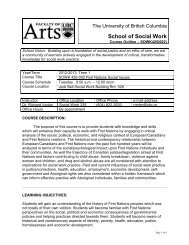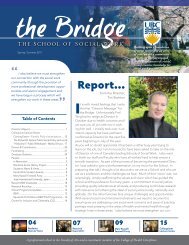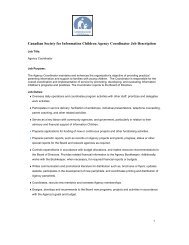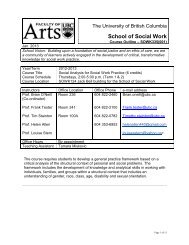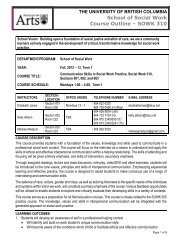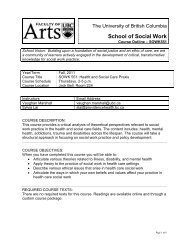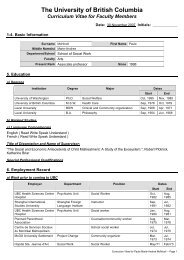Equity Case Studies Report - School of Social Work - University of ...
Equity Case Studies Report - School of Social Work - University of ...
Equity Case Studies Report - School of Social Work - University of ...
You also want an ePaper? Increase the reach of your titles
YUMPU automatically turns print PDFs into web optimized ePapers that Google loves.
UBC school <strong>of</strong> social work equity and diversity strategic plan: A compilation <strong>of</strong> case studies 50<br />
Since the development <strong>of</strong> the AMNI and Diversity Initiatives, there have been significant<br />
changes to address diversity issues in curriculum and teaching, and to find ways in which to best<br />
apply a diversity integration framework. In 1994, student evaluations about equity and diversity<br />
issues in the curriculum showed the need to pay greater attention to this area in different courses<br />
(George, Shera, & Tsang, 1998). In addition to the student evaluations, the annual student focus<br />
and discussion groups signalled the same need for changes (George, Shera, & Tsang, 1998). The<br />
Faculty’s response was to introduce a new required course on diversity, and to integrate more<br />
diversity content in each <strong>of</strong> the existing courses, as previously mentioned (George, Shera, &<br />
Tsang, 1998). This course was designed with four modules, which addressed: anti-racism,<br />
Aboriginal issues, issues <strong>of</strong> diversity and inclusiveness, and cultural competence (George, Shera,<br />
& Tsang, 1998). After these modules were decided upon, the Faculty then looked at how to<br />
implement this course. They asked the question, “Should it be a separate course, or should it be<br />
accommodated within the four existing, required courses at the MSW Year 1 program?”<br />
(George, Shera, & Tsang, 1998, p. 80). The Faculty made the decision to go with the latter<br />
option, where the course materials were presented during the first three weeks <strong>of</strong> the fall<br />
semester (George, Shera, & Tsang, 1998). After the first year <strong>of</strong> delivery, feedback and<br />
evaluations from students demonstrated the need to make some modifications. In 1996, a<br />
‘diversity assignment’ was created, where students worked in groups <strong>of</strong> five to collect firsthand<br />
information about populations or communities that experience multiple oppressions, and in the<br />
beginning <strong>of</strong> the second month <strong>of</strong> the fall semester, they made presentations <strong>of</strong> their findings to a<br />
panel (George, Shera, & Tsang, 1998). The grade received from this presentation counted for<br />
the first assignment for all four required classes (George, Shera, & Tsang, 1998). According to<br />
George, Shera, and Tsang (1998), this assignment established diversity content “as an integral



